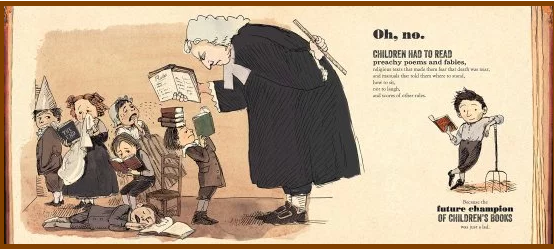Balderdash! John Newbery and the Boisterous Birth of Children's Books by Michelle Markel, illustrated by Nancy Carpenter
I wonder how John Newbery, namesake of the American Library Association's award for the most distinguished contribution to American literature for children, first given in 1922, would marvel at the range of books published especially for children today? It is hard to imagine a time when books were only for adults, but Michelle Markel's engaging and entertaining new book Balderdash! John Newbery and the Boisterous Birth of Children's Books, magnificently illustrated by Nancy Carpenter, sets the scene well, making it easy for children today to get a feel for this period in history. And, to match the splendid telling of Newbery's life, Balderdash! is a superbly illustrated, beautifully designed book. The marbled endpapers call to mind antique books and every two page spread is framed with the ragged-edged pages and worn covers of a well-loved, well-read book.
Above all else, Markel excels at characterizing John Newbery as a man who loved books - reading, of course, but the actual, physical book itself. I can relate to this. When we first meet John, he has "set off to work for a printer." He got a "kick out of type sticks and type stands and chases and quioins. He came to love galleys and presses and the smell of fresh ink." The illustrations for this page are glorious, with John ecstatically working the press and reverently smelling the ink.
John decides to go big time and moves to London where he sets up shop and, influenced by the words of philosopher John Locke's treatise, Some Thoughts Concerning Education, Newbery determines that children should have the right choice of learning materials, including "easy and pleasant books." Along with two other publishers, Newbery began printing books specifically for children.
What was most fascinating to me in reading Newbery's story was learning that he was quite the marketer when it came to moving merchandise. While his drive was to print books that would delight children, he smartly included a message to parents in his first publication, assuring them that reading fun books would not turn their "little nippets" into wild beasts. Newbery ordered gilt floral paper for the covers of A Little Pretty Pocket-Book, which sold for six pence. However, for eight pence, you could get a TOY with the book (a ball or a pincushion)! John went on to publish the first novel for children, believing, like adults, children also deserved, "One long, luscious story to savor for several days." His first novel, The History of Little Goody Two-Shoes, which was a huge success in England and America, told the story of a girl who, "goes from rags to riches without a fairy god mother," instead achieving it through, "study, hard work and kindness." The authors of these novels for children remained anonymous, although the author's note suggests that Samuel Johnson, Christopher Smart and Oliver Goldsmith might have penned some of Newbery's children's books under pseudonyms.
Markel includes excellent backmatter with further reading and a note on the books mentioned in Balderdash! You can visit The British Library where you can see images of one of the original Newbery books!
Source: Review Copy








